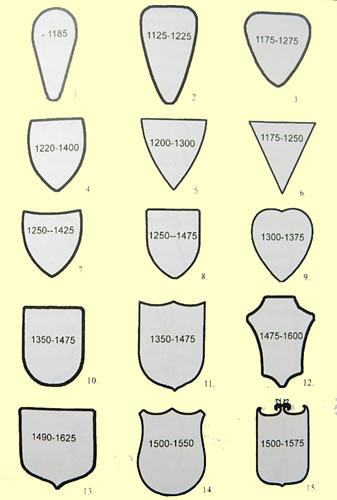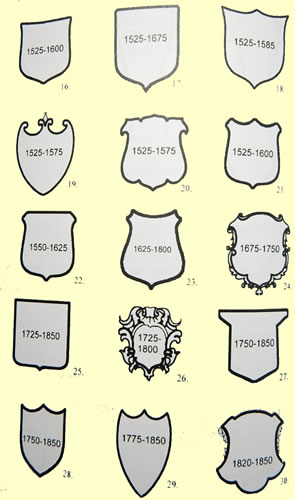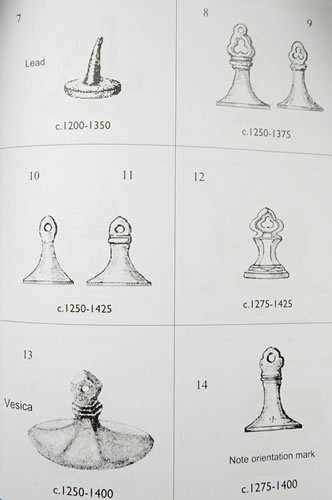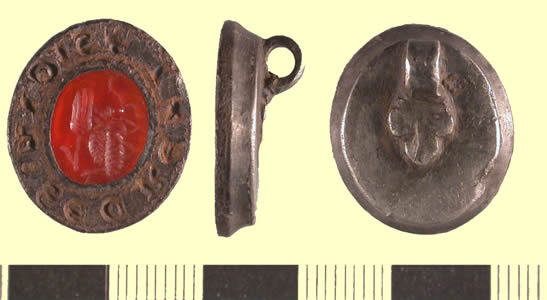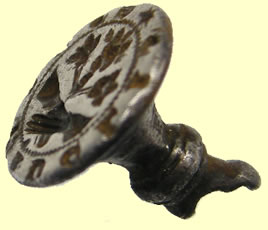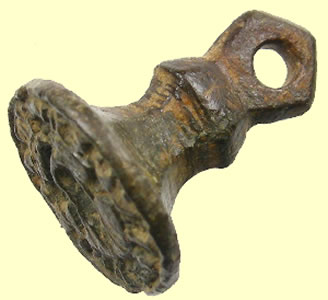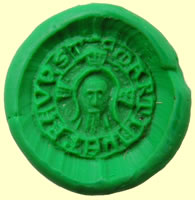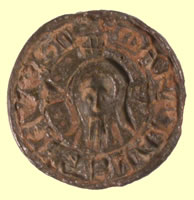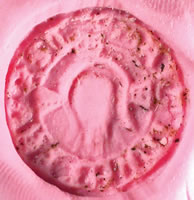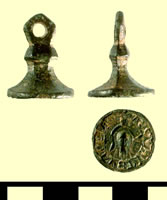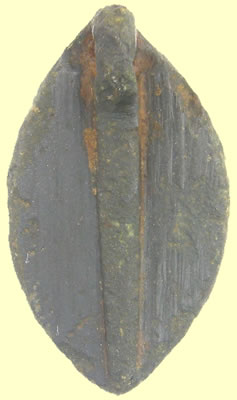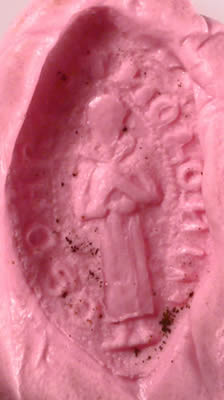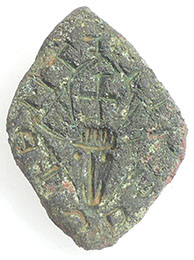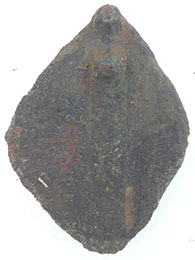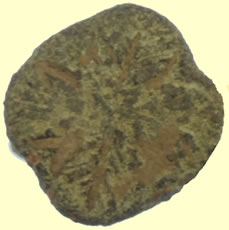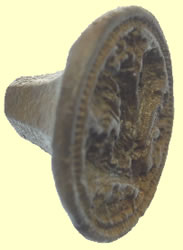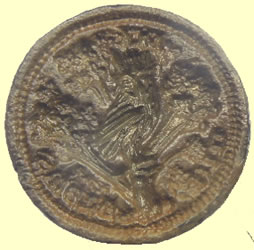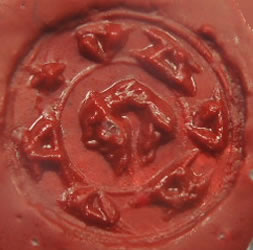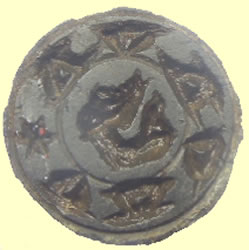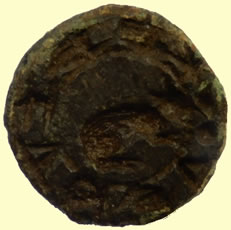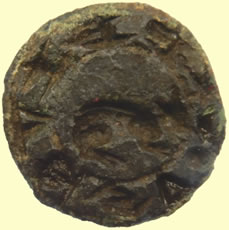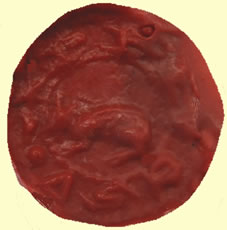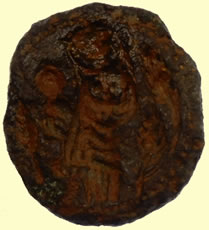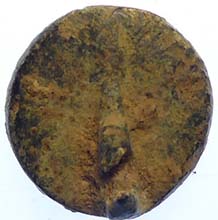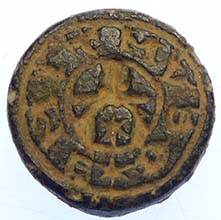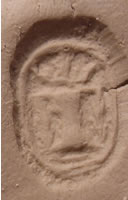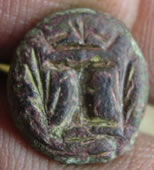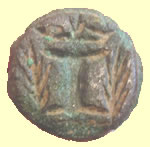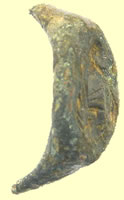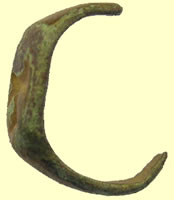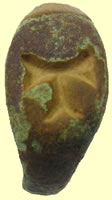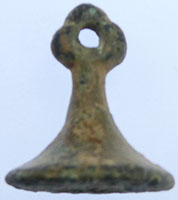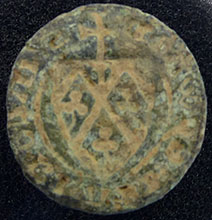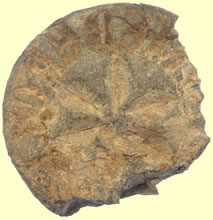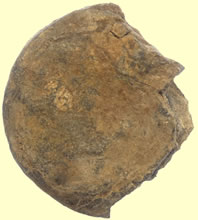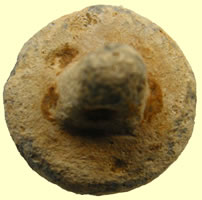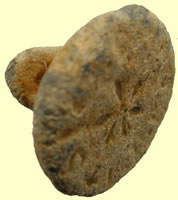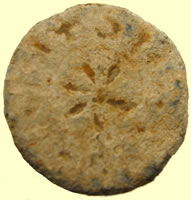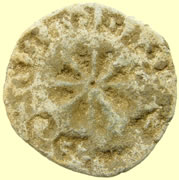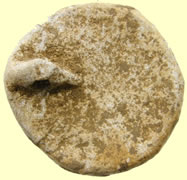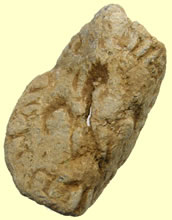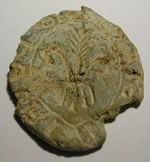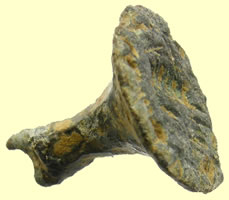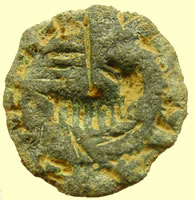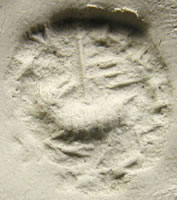

Metal detecting holidays in England with the World's most successful metal detecting club.20 years plus.
Twinned with Midwest Historical Research Society USA.
|
Medieval Seal
Matrix and Intaglio |
|||||||||||||||||||||||||||
|
Seal Types Click here for Post Medieval seals
Heraldic seal shapes - date periods
Typical seal shapes - date periods
Prior to the fifteenth century pointed oval designs, called vesica seals, were popular with noble women and also with high ranking ecclesiastics. The shape allowed room either to depict a full length standing figure of the owner, or alternatively to show scenes at two levels. Monastic seals often used the latter device, with a main, upper register depicting the monastery’s patron saint, and a small lower register in which the prior or abbot was shown praying. By the fifteenth century, vesica seals were somewhat out of fashion, but they still occur on documents, because monasteries in particular tended to continue using seal matrices made years — or sometimes centuries — earlier. By the fifteenth century, use of seals was widespread. One nobleman is said to have remarked acidly that in earlier times it had not been the custom for every Tom, Dick and Harry to use a seal. Most seals were quite small, and the most common forms of matrix were the pyramid seal (a small, usually circular design with a stem on the back, by which it could be held) and the signet, which could be of any shape (but was often circular or oval) and comprised the bezel of a ring. Seal impressions are usually of wax, though royal and papal seals were sometimes impressed in metal such as lead, or even gold. Such metal impressions were called bullæ. (This word is the origin of the expression ‘papal bull’, referring to a sealed letter from the pope.) Seal impressions were not directly attached to their documents, but hung from them on small strips of parchment or (for persons of high rank) silk threads. |
|||||||||||||||||||||||||||
ESS-A3AA61 Seal Matrix
TREASURE CASE: 2008 T233 Medieval silver seal matrix with roman intaglio. Weight 5.92 British Museum Report: A Medieval seal matrix, which is oval in shape and set at its centre with a orange-red carnelian, representing an ant climbing on a piece of vegetation. The legend reads: + S I G I L : S E C R E T I (Latin for “Secret Seal”) On the reverse is the suspension loop, which terminates in a trefoil. The intaglio is classical and probably dates to the 1st to 3rd centuries. The motif is quite unusual, although ants and other insects are sometimes represented on Classical gems. There are similarities between the body of the insect and Henig 712, and a possible dragonfly represented on Henig 713 (not illustrated). Henig 711 shows an ant of similar type but from above rather than in profile. (Henig, M. 1978. A corpus of Roman engraved gemstones from British Sites. BAR British Series 8). Dimensions: length 22 mm, width 18 mm. The seal matrix is silver and dates from the thirteenth century; as such it qualifies as Treasure under the terms of the Treasure Act 1996. J P Robinson Curator of Medieval Collections 18th August 2008 Subsequent actionsCurrent location of find: Acquired by Colchester & Ipswich Museum Service ChronologyBroad period: MEDIEVAL Dimensions and weightLength: 22 mm Materials and constructionPrimary material: Silver Secondary material: Gem Manufacture method: Multiple Completeness: Complete
Stunning c13thC medieval silver seal matrix - Crossed hands and flowers - reported as treasure to museum Lombardic lettering - Edward type E's and barred A's. Appears to be be "Esto Fidelis", which means 'be faithful'
|
|||||||||||||||||||||||||||
Stunning Circa 13thC 'bust of christ' medieval seal matrix - working on inscription MARTT NUE :PEVOSM
Medieval seal matrix - ESS-26B3A7
|
|||||||||||||||||||||||||||
ESS-0F1F33 Seal Matrix 13th C bronze Vessica seal matrix - 31.48mm H x 18.48mm wide - 8.45g Script - NOLONIM ESDARI : U Medieval (13th to 14th Century) cast copper alloy vessical seal matrix. The reverse has a central ridge along its length, with an integral loop at its apex. The matrix depicts a central standing figure, with hands clasped in front. The surrounding legend reads + NO HONI MESDONRI:' The matrix has a dark green patina. It is 31.75mm long, 18.22mm wide, 5.1mm thick and weighs 8.32 grams. Subsequent actionsSubsequent action after recording: Finder applying for an export licence ChronologyBroad period: MEDIEVAL Period to: MEDIEVAL Date from: Circa AD 1200 Dimensions and weightLength: 31.75 mm Materials and constructionPrimary material: Copper alloy Manufacture method: Cast Completeness: Complete
13thC vessica seal matrix It's our old friend CREDE MICHI -- "believe me" -- i.e. you can believe what is written beneath this seal as being genuine. The lettering is not perfect however! I'd transcribe CREDE [M]IChI. -- possible that the letter before the final C is meant to be MI ligatured, but if so, it's been bungled! Keep 'em coming -- and, ideally, nice easy ones like this! regards, Malcolm
13thC medieval seal matrix Image of
Tiny Medieval vessica shaped pendant type seal matrix
13th C seal matrix - bird facing left
Tiny Medieval seal matrix - sent off for our seal expert Malcolm views
Medieval seal matrix - owl in a tree
Medieval seal matrix - Birds head Obv * VANAVA
Medieval seal matrix - fox facing right Needs more cleaning yet Legend PRIVE SV
Medieval seal matrix - cleaning in order to take a wax impression
By my count on the database there are 4 boars' heads coouped with legend CREDE MICHI, 2 with PRIVE/PREVE SV, 1 LEGE TEGE and 1 "IE SV CEI IEL" [which must be IE SV SEL LEL] -- if you orient it so that the head is exactly horizontal, you'll see the "New Readers start here" star exactly at 12 o'clock where it should be, and then one of the few letters I can make out is the prominent V -- exactly where it should be for PRIVE/PREVE and I think I can see the following SV ... BUT! the lettering seems to continue, so if it is PRIVE SV or PREVE SV, there must be another word or two after that, e.g. E LEL (and loyal/faithful) which I think does sometimes occur as an extension of the simple PRIVE SV -- I'm not saying yours DOES say E LEL -- merely quoting that as an example! Malcolm
Medieval seal matrix - Madonna and child impression Detail is cleaning up nicely
Medieval seal matrix - pendant type *DEVM +IVM (Fear of god) |
|||||||||||||||||||||||||||
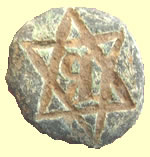 |
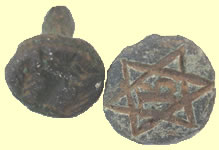 |
||||||||||||||||||||||||||
|
2- 15thC seal matrix - Jewish symbol Anonymous: letter I early 15thC. An initial with crown above, branches at the side, was a design that became incrreasingly common in the 15thC and was often used on a signet ring as below. The letter suggests it stood for the owners forename. This example was used in 1424 by Edward Saddler, clerk
Seal ring of Edward Saddler
More medieval seal matrix used by Edward Saddler
Medieval bronze seal ring - bearded figure sitting - 2.70g, 18.86 mm dia x 9.62 mm W
Medieval traders seal rings
13th C seal matrix
Medieval Knights Templar finger ring - matrix Founded in Jerusalem in 1118 by Hugo de Payns and eight other French knights, with the name of Poor Knights of Christ. Their mission was to protect pilgrims who came to the Holy Places. Later, the king of Jerusalem, Baldwin II, installed them in the near the ancient temple of Solomon palace, so they changed their name to the Knights Templar. During the time of the Crusades, the Templars actively participated in the defense of Palestine, which had many strengths. At the same time they acted as bankers pilgrims, so they obtained great wealth. Being expelled the Christians of Palestine, the Templars retreated to Cyprus. In the Iberian peninsula they were established during the twelfth century; first in Catalonia, Aragon and Navarra. They were responsible for the defense of the borders and participated in numerous expeditions against the Muslims (conquest of Lleida, Tortosa, Valencia, Mallorca, etc.). On the death of Alfonso the Battler were named heirs, along with other military orders, the kingdom of Aragon; in exchange for his resignation inheritance received various strengths. All this contributed to the economic and social dominance of the Templars were ever increasing, so that in the thirteenth and fourteenth centuries owned large estates in the eastern part of the peninsula. In the castellanoleonés kingdom they were established shortly after Aragon, also collaborating in the task of Recapture. Alfonso VII gave them the strength of Calatrava; They collaborated in making Cuenca, in the famous battle of Las Navas de Tolosa (1212) and the conquest of Seville. In France, the Templars had become bankers of kings. Philip IV the Fair, dedicated to seize their property, convinced Pope Clement V that initiate a process against the Templars, accusing them of impiety (1307). The Grand Master of the Order, Jacques de Molay, and 140 members were arrested. Presumed innocent at the Council of Vienne (1311), Clement V dissolved the order and created a commission to reeprendió the process. They were sentenced to prison, but the royal council of Philip IV sentenced to death by relapses. The king seized their chattels and gave his possessions to the hospital. In the other European countries did not prosper the allegations but, following the dissolution of the order, the Templars were dispersed and their property passed to the Crown (Castilla), other orders new foundation (Montesa in Valencia and Jesus Christ in Portugal). |
|||||||||||||||||||||||||||
 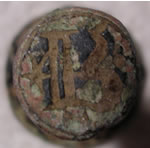 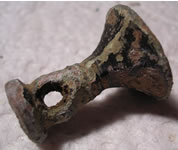 |
|||||||||||||||||||||||||||
|
This
early 13thC Medieval seal matrix is a superb example and is very unusual
having a seal matrix on both ends. One end has a shield with lombardic
script around the outside and the other has 2 letters
|
|||||||||||||||||||||||||||
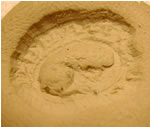 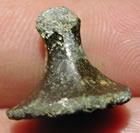 |
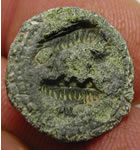 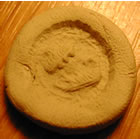 |
||||||||||||||||||||||||||
|
13th/14thC
seal matrix - impression looks like a frog or toad (c) |
12thC seal matrix. The clay impression clearly shows a falcon attacking a bird lying on it's back | ||||||||||||||||||||||||||
 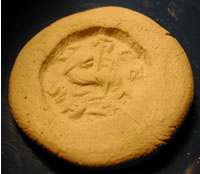 |
|||||||||||||||||||||||||||
|
13thC seal
matrix, lamb with legs tucked underneath
|
|||||||||||||||||||||||||||
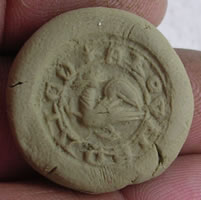  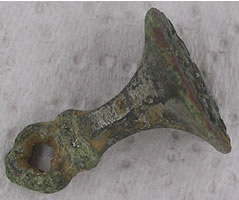 |
|||||||||||||||||||||||||||
|
Stunning
condition 13th to 15thC seal matrix |
|||||||||||||||||||||||||||
 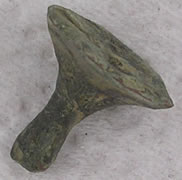 |
|||||||||||||||||||||||||||
|
13th to
15thC seal matrix - 2 people facing with heart in the middle |
|||||||||||||||||||||||||||
Lead Seal Matrix
|
|||||||||||||||||||||||||||
 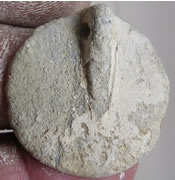 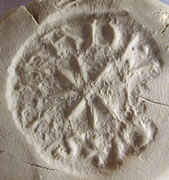 |
|||||||||||||||||||||||||||
1260 AD Non Heraldic personal seal of freeholders of Charwelton Nothhamptonshire. 4 have been found attached to pasture rights. The design is typical of mid 13thC non heraldic seals like the one published on the 23rd Jan post, a fleur -de- lis, a flower, the lamb of god and each names it's owner on the legend
Medieval (13th century) lead alloy seal matrix. It is circular in plan, with a small triangular suspension loop on the reverse. The central design is a flower with six petals. The legend is illegible. It is 27.52mm in diameter and weighs 11.26 grams. Subsequent actionsSubsequent action after recording: Finder applying for an export licence ChronologyBroad period: MEDIEVAL Date from: AD 1200 Dimensions and weightWeight: 11.56 g Materials and constructionPrimary material: Lead Manufacture method: Cast
|
|||||||||||||||||||||||||||
ESS-0C2DF2 Seal Matrix Medieval, circular, lead seal matrix. The matrix has a central 6 petalled flower design, surrounded by the legend +SIGIL.RICARDI.FILL.RAVVLI 'The seal of Richard, son of Ravvli'. The reverse has an integrally cast suspension loop, and a central raised six petalled flower, surrounded by curved lines. It is 32.75mm in diameter, 4.39mm thick excluding the suspesion loop and weighs 24.56g. Subsequent actionsSubsequent action after recording: Finder applying for an export licence ChronologyBroad period: MEDIEVAL Period to: MEDIEVAL Date from: Circa AD 1300 Dimensions and weightThickness: 4.39 mm Materials and constructionPrimary material: Lead Manufacture method: Cast Completeness: Complete
1260 AD Non Heraldic personal seal 4 have been found attached to pasture rights. The design is typical of mid 13thC non heraldic seals.
Seal of RICARD I. DE
Huge lead hanging seal matrix - circa 15thC Partial legend
Circa 13thC Medieval lead seal matrix + S'IOhA (short for S[igillum] Iohannis)
Medieval (13th century) lead alloy seal matrix. It is circular in plan. The central design is a flower with six petals.
Medieval (13th century) lead alloy seal matrix with complete supsension loop - Fleur de Lis |
|||||||||||||||||||||||||||
First 13thC pasture seal type seal matrix I have seen with this type of suspension loop
|
|||||||||||||||||||||||||||
 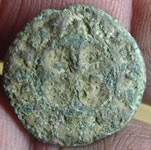 |
  |
||||||||||||||||||||||||||
Medieval seal matrix |
c
13thC Medieval seal matrix |
||||||||||||||||||||||||||
   |
|||||||||||||||||||||||||||
Medieval seal matrix 20.22m dia , 9.34g |
|||||||||||||||||||||||||||
   |
|||||||||||||||||||||||||||
Early Medieval seal matrix - bell type
|
|||||||||||||||||||||||||||
a.5 [the most interesting one!] I call this type of dragon a 'cockatrice', and there is a close parallel both as to device and legend on the PAS -- IHS-65F414. Yours appears to me to read IE SV NVLSCEL. The last word 'ought to be' NVTEL [nonesuch] Malcolm 13thC Medieval bronze seal matrix - sacrifical lamb impression Legend CVNVL*CEL * ESS-26D793 Seal Matrix Incomplete Medieval cast copper alloy seal matrix. The matrix is circular with a broken faceted handle on the reverse. The design is of a lamb with flag. The surrounding legend reads *--SVNVLEGEL, which could be read as [....]SV NV LE GEL, or the ending could be LEGE L, as Lege (read) is often a componant of inscriptions. The central design of a lamb with flag is often accompanied by the inscription ECCE AGNUS DEI, although that is not the case with that example. It is 17.19mm in diameter, 8.77mm thick and weighs 4.61 grams. Notes: With thanks to Laura Burnett and David Williams for their interpretation of the legend.
Subsequent actionsSubsequent action after recording: Finder applying for an export licence ChronologyBroad period: MEDIEVAL Date from: AD 1200 Dimensions and weightThickness: 8.77 mm Materials and constructionPrimary material: Copper alloy Manufacture method: Cast Completeness: Incomplete
|
|||||||||||||||||||||||||||
|
|||||||||||||||||||||||||||
Medieval bronze vessica seal matrix - crow impression facing left |
|||||||||||||||||||||||||||
 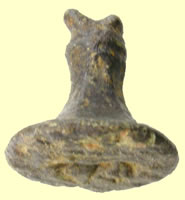 |
|||||||||||||||||||||||||||
Medieval seal matrix - appears to be an impression of a squirrel facing right |
|||||||||||||||||||||||||||
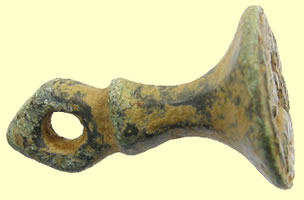  |
|||||||||||||||||||||||||||
15thC traders seal matrix - IR inscription |
|||||||||||||||||||||||||||
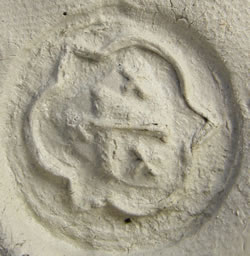 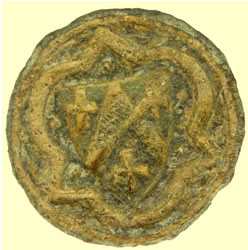 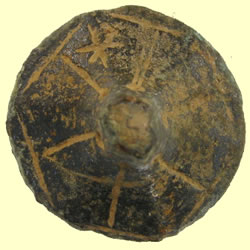 |
|||||||||||||||||||||||||||
Fantastic circa 13thC Medieval seal matrix with heraldic shield impression - this seal is first I have seen with additional decoration on the 'bell' top It will be interesting if we can find the family crest and who it belonged to Ok, here is my best guess. Cal Jim
|
|||||||||||||||||||||||||||
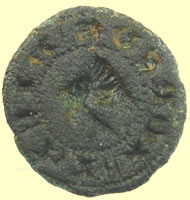 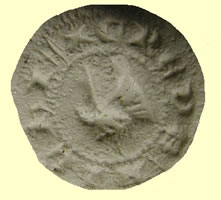   |
|||||||||||||||||||||||||||
Cleaned up medieval seal matrix, the impression appears to be two birds mating ? Legend *CREDE MICHI II |
|||||||||||||||||||||||||||
13thc Vessica seal matrix - Sacificial lamb of god - ECCEAG NVS DEI
c13thC Medieval seal matrix - sacrificial lamb type
C13thC Medieval vessica seal matrix - appears to be a prancing Lion - soaking it in distilled water to clean up impression
|
|||||||||||||||||||||||||||
-

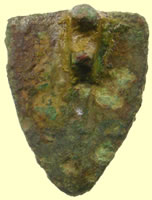
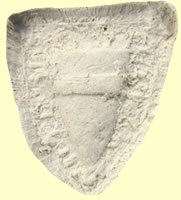
14thC Medieval heraldic seal matrix - plain shield with single fesse
Tamas de Kent ?
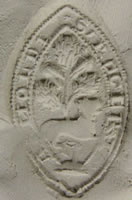
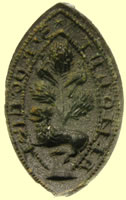



Mint 13thC vessica seal matrix
Lamb and tree of life
S' ROGER' ( seal of Roger)
ALEE ODOC
Prior to the fifteenth century pointed oval designs, called vesica seals, were popular with noble women and also with high ranking ecclesiastics. The shape allowed room either to depict a full length standing figure of the owner, or alternatively to show scenes at two levels. Monastic seals often used the latter device, with a main, upper register depicting the monastery’s patron saint, and a small lower register in which the prior or abbot was shown praying. By the fifteenth century, vesica seals were somewhat out of fashion, but they still occur on documents, because monasteries in particular tended to continue using seal matrices made years - or sometimes centuries - earlier.



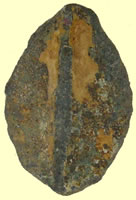
13th C Medieval seal matrix - need soaking to remove crust on seal face 13thC Vessica seal matrix
can't make out the central device on this vesica seal but I read IE SV [SEL DA]MVR LEL [the common "I am a seal of loyal love"] -- common on the later circular matrices
Malcolm




Medieval seal matrix - Cockerel impression 17thc seal matrix - thistle inscription 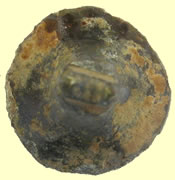

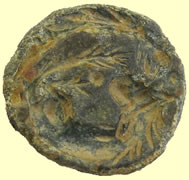

Human face on a rat's body impression?
13thC Medieval seal matrix
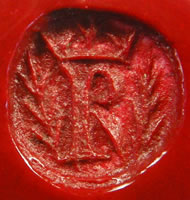

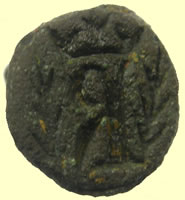
13thC seal matrix
Anonymous: letter R An initial with crown above, branches at the side, was a design that became incrreasingly common in the 15thC and was often used on a signet ring. The letter suggests it stood for the owners forename. Examples were used in 1424 by Edward Saddler, clerk.


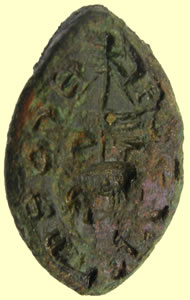
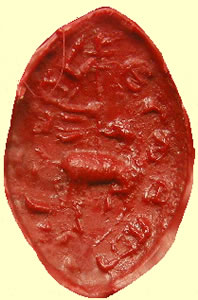

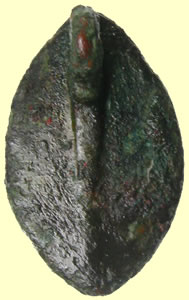
13th C bronze Vessica seal matrix - needs a soak and pick to clean legend and impression
Now partially cleaned up shows a sacrificial lamb type impression


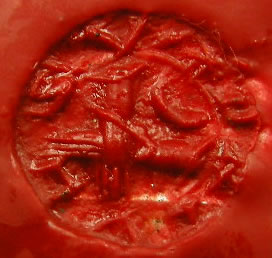
Medieval seal matrix 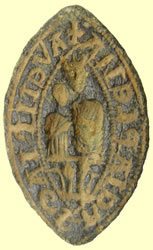
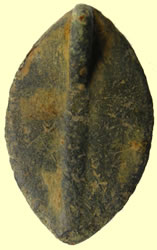
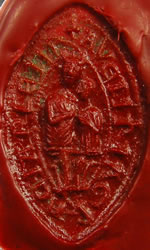
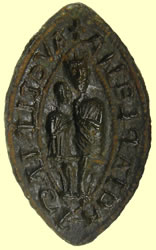

Simply stunning cleaned up 13thC vessiaca seal matrix with wax impression taken - Madonna and child
+ AVE TIR TAG R
ACIA PLENA (full of (gr)ace)
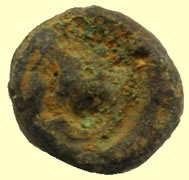



Unusually small medieval bell shaped seal matrix - needs cleaning to see impression circa 13thC seal matrix
This is a squirrel and I think it's 'the usual' I CRAKE NOTIS -- [I crack nuts]
Malcolm

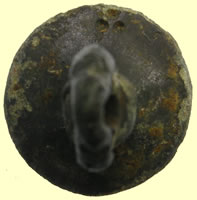

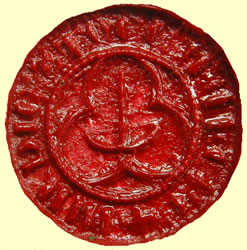
Stunning 13thC seal matrix
Triple dot makers mark
+ I'IR DIG ' ZTOEC H ' II 'R'
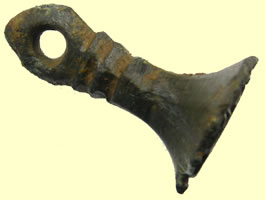
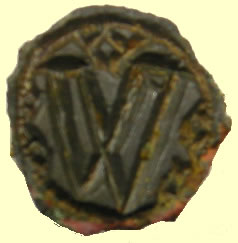


13thC medieval seal matrix - letter W indicates traders initial First shield shaped 12thC seal matrix I have seen found here - got to clean it up and do a wax impression yet
A copper alloy matrix with shield-shaped face and six-sided handle terminating in a rhomboid suspension loop with circular perforation. Device of a heraldic lion rampant
This shield-shaped matrix bears a heraldic lion rampant; does not imply that the owner used such a lion as his arms or, indeed, that he bore arms at all; many such matrices carry heraldic creatures.
Date from: AD 1200
Date to: AD 1400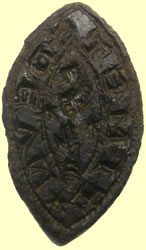
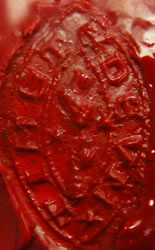
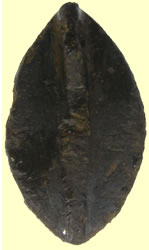
13thC vessica seal matrix
Interesting impression of an open hand with two stars above reaching for a closed fist
Legend - EDEVM * TIMET


Medieval seal matrix


13thC medieval seal matrix



13thC seal matrix
pretty sure this 4-leaf clover reads -- as 9 others of the same device on the PAS do -- LEL AMI AVET [you have a faithful 'friend' i.e. lover]
Malcolm



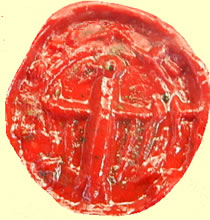

13thC seal matrix with winged bird looking left impression - mad beak and eye



13thC seal matrix - needs a good clean up to ID yet

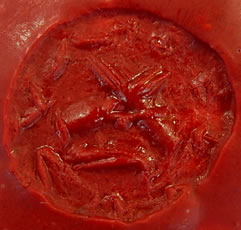


13thC seal matrix - clasped hands impression
S'BES VSV - Seal of BES VSV


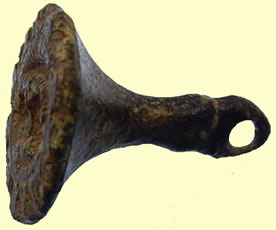

Medieval seal matrix
a.6 another squirrel and this time the legend is definitely the common I CRAKE NOTIS [I crack nuts]
Malcolm
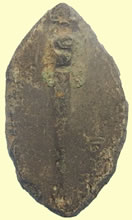
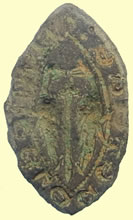
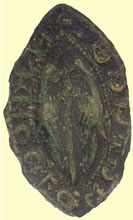
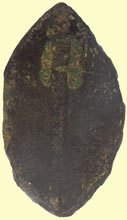
13thC medieval vessica seal matrix - needs cleaning up to take impression
2 birds with central sword


Anonymous: letter I early 15thC. An initial with crown above, branches at the side, was a design that became incrreasingly common in the 15thC and was often used on a signet ring as below. The letter suggests it stood for the owners forename. This example was used in 1424 by Edward Saddler, clerk


Medieval seal matrix

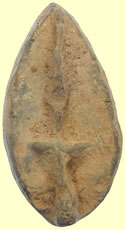
Medieval vessica seal matrix
So AVICDE - Seal of avicde


Uninscribed medieval seal matrix
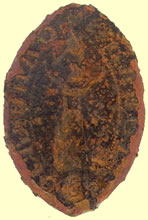

13thC copper vessica seal matrix - figure standing


Medieval seal matrix - squirrel facing right

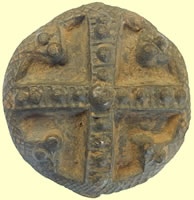

Medieval religious mount - could even be a weird seal matrix design
Inscribed TD


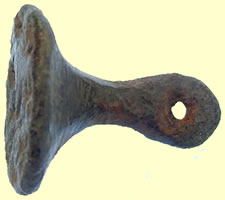
Medieval seal matrix
Jack rabbit facing right with long ears
Legend IVEIS'V * CI
Seal of Iveis


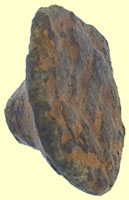
Medieval seal matrix
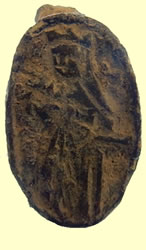
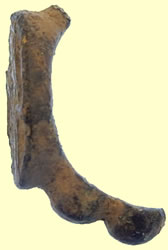
Spectacular Medieval seal ring - Madonna and child


Medieval seal matrix
Horse facing right


c13thC Medieval seal matrix - bird facing left


Extra large 13thC seal matrix - - sacrifical lamb impression
The central design of a lamb with flag is often accompanied by the inscription ECCE AGNUS DEI, although that is not the case with that example.


Very unusual to have a c13thC 'round type' medieval seal matrix with suspension loop. Normally the vessica type seals are suspension but round types are always bell type.



13thC medieval seal matrix - rabbit surround by star of David -market traders seal


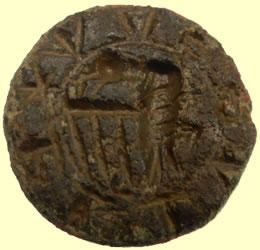
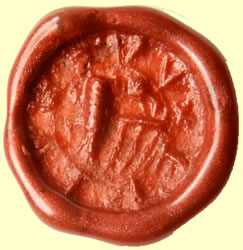
13thC seal matrix
Bird facing right with double long beak
Legend PRIVE SV (I am private)
Sent to our seal expert for his views
It's another PRIVE SV, Chris. HAMP-EA9E0$ and SF-470BCD are particularly close with the upraised and spread wing. If you simple search "matrix bird PRIVE SV" you'll find parallels. In this case I found it was much clearer simply reversing the original than looking at the impression -- sometimes it's like that!
regards,
Malcolm



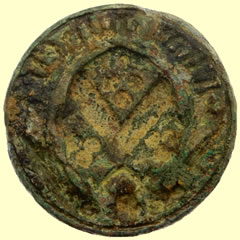

Biggest medieval seal matrix I have seen dug
The big impression looks the most promising for a reading. Pretty sure it begins with the usual s' for 'sigillum' then I think I see Icha which made me wonder whether this might be a Richard -- but that definitely looks like the expected 's' before it and there seems to be no trace of an R. The next few letters look irrecoverable but the 2nd name/surname may end in els
Sorry -- can't win em all!
Malcolm



Medieval seal matrix - needs cleaning to reveal impression


Medieval seal ring - Fleur de Lis
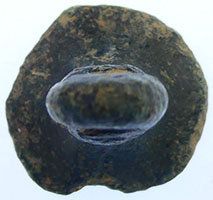

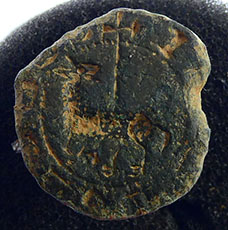
13thC Medieval bronze seal matrix - sacrifical lamb impression
The design is of a lamb with flag.

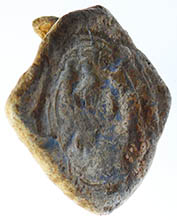
Medieval lead seal
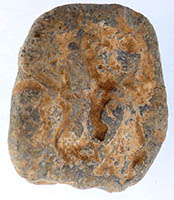
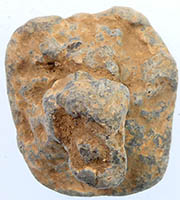
Crude medieval lead seal matrix


Medieval lead vessica seal matrix
S'DR' W D R I N D
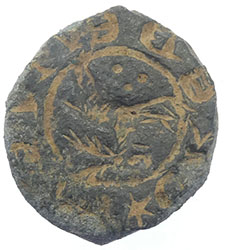

Medieval vessica seal matrix - Bird facing right

